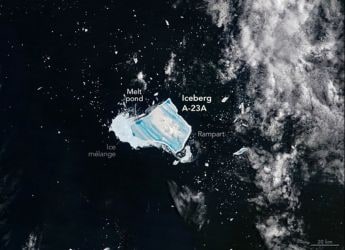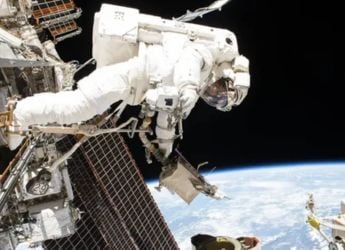- Home
- Science
- Science News
- James Webb Space Telescope Ends Debate Over the Mysterious ‘Hubble Tension’, Finds Study
James Webb Space Telescope Ends Debate Over the Mysterious ‘Hubble Tension’, Finds Study
A group of researchers measured the expansion rate of universe using light from 10 nearby galaxies using three different methods.

Photo Credit: NASA
The Hubble tension is a key factor in understanding the universe's history
Recent analysis of data from the James Webb Space Telescope (JWST) has provided new measurements of the universe's expansion rate, offering fresh insights into the long-standing debate known as the "Hubble tension." For years, astronomers have struggled to reconcile two major methods of measuring the universe's expansion, which have produced differing results. The new study, led by University of Chicago astronomer Wendy Freedman, measured the expansion rate using light from 10 nearby galaxies using three different methods. The findings suggest that the perceived conflict between these methods may not be as significant as once thought.
Understanding the Hubble Tension
The Hubble constant, which measures the rate of the universe's expansion, is a key factor in understanding the universe's history. Traditionally, two methods have been used to calculate it: one based on the cosmic microwave background radiation from the Big Bang, and the other on observing stars in nearby galaxies.
The former method has consistently produced a lower value, while the latter has yielded a higher rate, leading to speculation that something fundamental might be missing from our current cosmological models. This missing data was denoted using the term Hubble tension.
New Data from Webb Telescope
Using the Webb Telescope, Freedman and her team analyzed light from 10 nearby galaxies, applying three independent methods to measure the expansion rate. These methods involved Cepheid variable stars, the Tip of the Red Giant Branch, and carbon stars, all known for their predictable brightness. The results aligned closely with the cosmic microwave background method, suggesting the two previously conflicting measurements may not be as different as previously thought.
Impact on Cosmology
The findings from this study are significant because they suggest that the standard model of the universe's evolution might still be accurate. While the debate over the Hubble tension continues, this new data provides a clearer picture and could guide future research. Freedman told Phys.org that ongoing observations with the Webb Telescope will be essential in resolving this issue and understanding its broader implications for cosmology.
Catch the latest from the Consumer Electronics Show on Gadgets 360, at our CES 2026 hub.
Related Stories
- Samsung Galaxy Unpacked 2025
- ChatGPT
- Redmi Note 14 Pro+
- iPhone 16
- Apple Vision Pro
- Oneplus 12
- OnePlus Nord CE 3 Lite 5G
- iPhone 13
- Xiaomi 14 Pro
- Oppo Find N3
- Tecno Spark Go (2023)
- Realme V30
- Best Phones Under 25000
- Samsung Galaxy S24 Series
- Cryptocurrency
- iQoo 12
- Samsung Galaxy S24 Ultra
- Giottus
- Samsung Galaxy Z Flip 5
- Apple 'Scary Fast'
- Housefull 5
- GoPro Hero 12 Black Review
- Invincible Season 2
- JioGlass
- HD Ready TV
- Laptop Under 50000
- Smartwatch Under 10000
- Latest Mobile Phones
- Compare Phones
- OnePlus Turbo 6V
- OnePlus Turbo 6
- Itel Zeno 20 Max
- OPPO Reno 15 Pro Mini 5G
- Poco M8 Pro 5G
- Motorola Signature
- Vivo Y50e 5G
- Vivo Y50s 5G
- Lenovo Yoga Slim 7x (2025)
- Lenovo Yoga Slim 7a
- Realme Pad 3
- OPPO Pad Air 5
- Xiaomi Watch 5
- Huawei Watch 10th Anniversary Edition
- Acerpure Nitro Z Series 100-inch QLED TV
- Samsung 43 Inch LED Ultra HD (4K) Smart TV (UA43UE81AFULXL)
- Asus ROG Ally
- Nintendo Switch Lite
- Haier 1.6 Ton 5 Star Inverter Split AC (HSU19G-MZAID5BN-INV)
- Haier 1.6 Ton 5 Star Inverter Split AC (HSU19G-MZAIM5BN-INV)

















